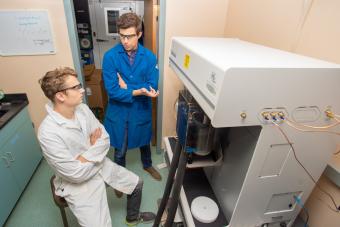Mike McGuirk wins NSF CAREER Award to explore chalcogen bonding for next-gen materials
New class of crystalline framework materials could be used for solar energy production, low-density conductors and more

Assistant Professor of Chemistry Mike McGuirk, center, conducts research that aims to address fundamental challenges related to organic and hybrid materials, supramolecular assembly, and environmental sustainability.
Mike McGuirk, assistant professor of chemistry at Colorado School of Mines, has received a National Science Foundation CAREER Award for research that could contribute to the discovery of new materials for solar energy production, low density conductors and more.
McGuirk will receive $756,000 over five years for the project, which will focus on chalcogen bonding, a recently discovered interaction between molecules that scientists believe could lead to the realization of a new class of crystalline framework materials: Chalcogen-Bonded Organic Frameworks.
“We like to think of this like exploring new ways of linking the materials used to build a house,” McGuirk said.
Here, he talks about his research, those 3D model kits from your high school chemistry class and why his work motivates him to jump out of bed in the morning.
Q: What is your latest research focused on?
A: Our work explores if chalcogen bonding, a recently discovered interaction between molecules, can be broadly leveraged to assemble molecules intuitively and reliably into a new class of low-density, porous framework materials. We like to think of this like exploring new ways of linking the materials used to build a house. Materials like bricks and wood only become a house when they are deliberately connected in space through a robust link that will stand the test of time, like nails or mortar.
Similarly, we are seeking to understand if chalcogen bonding should join the ranks of other long-studied inter-molecule linkages, like covalent, hydrogen, and coordination bonds, in the realm of synthesizing porous frameworks. These efforts build on our recent discovery of the first example of a porous chalcogen-bonded framework published in 2021.
Q: What do you find most exciting about your research?
A: Only in the past few years have scientists begun to study chalcogen bonding in the lab. Therefore, much about the fundamentals of this inter-molecular interaction is still poorly understood. Through our pursuit of porous framework materials built with chalcogen bonds, we will move the needle on the fundamental understanding of chalcogen bonding. The adage is that you need to know how a car works to fix it. Similarly, we need to understand everything we can about chalcogen bonding to use it as a tool for building materials. The idea of contributing knowledge that could one day end up in the textbooks that the next generation of chemists read is a reason to jump out of bed in the morning.
Q: What is the potential impact of this work?
A: Since their discovery about 25 years ago, porous framework materials assembled through coordination or covalent bonds have led to a materials revolution. With this broad class of materials, chemists can design and synthesize nanoscale and sub-nanoscale environments across many orders of magnitude. This has led to great leaps in a broad assortment of applications, such as water harvesting from arid environments, capture of CO2 from the burning of fossil fuels, and even the delivery of small snippets of DNA to cells. Yet, there remains prevalent gaps in the desired properties of these materials, which can’t be met through coordination or covalent bonds.
Because of its unique combination of physical properties, we hypothesize that porous frameworks built through chalcogen bonding will exhibit structural and physical properties complementary to established systems, therefore filling functional gaps of established systems. For example, we believe chalcogen-bonded frameworks have great potential in the realms of solar harvesting for clean energy production, self-healing materials, and electron conduction. Furthermore, the establishment of this complementary class of materials, along with insights from proposed fundamental studies, will help cement chalcogen bonding as a reliable and intuitive interaction in the chemistry and materials community.
Q: How does this research agenda inform your teaching?
A: Before the advent of digital representation and 3D printing, exercises with model kits were the only way students could visualize the three-dimensional nature of molecules and crystalline lattices. With model kits, students get a hands-on understanding of the rules that govern the structure of molecules and the materials they compose. The economic accessibility of model kits is also key. Modeling exercises using inexpensive everyday materials – such as marshmallows as atoms and toothpicks as bonds – are particularly powerful for equal accessibility in education and community outreach.

Inspired by this importance and efficacy of model kits, our team will develop the first model kit exercise for teaching what influences how molecules assemble into materials. Using multi-colored modeling clay and toothpicks, we will develop a hands-on exercise to teach how a combination of molecular shape and the relative strength of molecular interactions determine the assembly of materials. Due to its flexibility, this inexpensive model kit platform can be readily adapted from the middle school classroom to the undergraduate lecture hall. We hope that this simple and inexpensive exercise will be broadly shared, piquing the interest of young students into the world of chemistry and materials.




